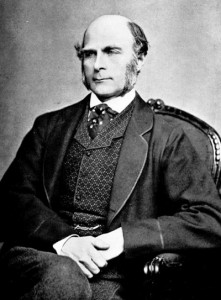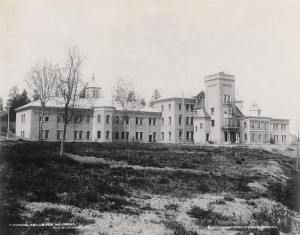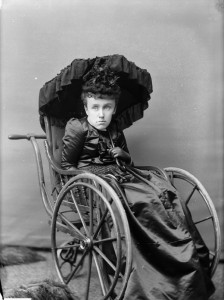7.8 Eugenics

One of the earliest and longest lasting of the reform movements was associated with the ideals of eugenics. Formulated in its modern context in 1883 by the English intellectual, Sir Francis Galton, eugenics took its lead from evolutionary and genetic theory, and was at the heart of what came to be known as scientific racism.
Gene Theory
The core idea of the eugenic theory is that genetic inheritance is a factor in the success or failure of a society. Along with Galton, the proponents of eugenics “believed that criminality, alcoholism, and feeble-mindedness were…inherited.”[1] Individuals who are mentally or physically (and, sometimes, morally) challenged are doomed, the eugenicists argue, to pass along those traits to their heirs (which, it is now widely understood, was never the case). A person with a severe mental challenge like Down syndrome, for example, was reckoned incapable of conceiving a child without Down syndrome. Poverty and laziness (often paired as personal qualities) were sometimes viewed as heritable as well. According to eugenic theory, poverty (a condition of life that can be instantly changed with money) was not caused by changes in the economy or social circumstances: it was the consequence of bad genes. Moral weakness was also aligned with “feeble-mindedness.” This was especially true as regards eugenicists’ views of sexually active women (who were responsible, it was argued, for a rising tide of illegitimate births) and sex trade workers.
The eugenicist strategy has been described as “selective breeding,” but that term does not do it justice.[2] “Selective breeding” invariably involves selecting in: that is, encouraging fit people (however defined) to have a significant number of children. But the eugenics message in Canada was more about selecting out: to find ways to deter the reproduction of what they regarded as fated populations who were doomed by their genes to imperil themselves, successive generations, and the nation as a whole. In this campaign, they were not alone.
Part of the late 19th century context of eugenics in English-Canada was the falling fertility rate, particularly when measured against that of French-Canada and immigrant communities (see Section 1.2). Eugenicists internationally claimed that healthy societies were at risk from this fertility transition. Most of these cultures were hostile to the idea of birth control because it would limit the reproduction of their own people, but the idea of sterilizing the least healthy and least valued citizens had considerable appeal.
Nazi Germany, of course, ran headlong down this path and became notorious for the forced sterilization of roughly 360,000 individuals who failed to meet one test or another of “normalcy.” The fascists did not have a monopoly on eugenics: it is reckoned that, in the United States from 1910 to the 1970s, no fewer than 60,000 “feebleminded” citizens were forcibly sterilized. Canada sterilized proportionately fewer — the total number is believed to be slightly in excess of 3,000 – but record keeping was inconsistent and there is little doubt that a true total is unknowable.[3]
What is distinctive about this particular branch of social reform in Canada is that its advocates sought to change the human raw materials rather than the laws or conditions under which those humans lived. To quote the authority on this subject, historian Angus McLaren, “The eugenicists differed from most of their contemporaries not so much in envisaging a radically different future, but in supporting the intrusive social policies they felt were needed to bring it into being.” [4] While other social reformers were encouraging redemption through personal choice and institutional supports, the eugenicists were advocating change at the sharp end of a scalpel.
A Nation of Thoroughbreds
Eugenics in Canada had two principal roots. These were the deteriorating health of urban working people and a visible increase in the numbers (though not necessarily the incidence) of mental health cases. There was no shortage of evidence that urban work made people less well and the eugenicists feared that those weaknesses would be transmitted to successive generations. As for the mentally ill, their institutionalization and observation got underway in the mid-19th century with the construction of redoubtable asylums in the major cities. It was not until the early 20th century, however, that eugenic thinking produced eugenic action. This took place at the provincial level because of the allocation of powers under the BNA Act, but it was only Alberta and British Columbia that moved forward with forced sterilization policies and campaigns.

Originally the Albertan legislation of 1928 did not permit involuntary sterilization but it was nevertheless coercive. Patients were more likely to be discharged from an asylum or hospital if they elected to be sterilized; there was an incentive, then, to go under the knife. This was evidently insufficient as far as Edmonton was concerned, and under the Social Credit government of William Aberhart, the Board of Eugenics was given the power in 1938 to make sterilization compulsory. The Board’s record of recommendations is astonishing: only 1% of cases considered were not recommended for immediate sterilization, and that tiny fraction was, in actuality, postponements. As one study of the Alberta Board of Eugenics states succinctly, “not once did it vote “no”.”[5]
Scholars working in this field think that British Columbia’s experiment with eugenic policies was less dramatic in its numbers. The problem is that record keeping on this score was remarkably incomplete, and what records were kept were subsequently destroyed or lost. We do know, however, that sterilizations were performed on inmates in mental health and prison facilities beginning in 1933; perhaps a few hundred were affected.
The eugenics movement in Western Canada and the application of sterilization is discussed by historian of institutionalization, Megan Davies (York University).
Fear of the Other
What these initiatives and the appeal of eugenics generally had in common was a fear of immigrants. One study points to the “convergence” of the study and management of public health, reform of educational systems, and concerns for immigrant selection in the 19-teens as a flashpoint in the development of eugenic sentiment. According to one historian of immigration, this was made
… evident in a 1920 editorial of the Canadian Journal of Mental Hygiene, which observed that the feeble-minded, insane, and psychopathic found in the province of Manitoba came out of all reasonable proportions from the immigrant class, and it was found that these individuals were playing a major role in such conditions as crime, juvenile delinquency, prostitution, pauperism, certain phases of industrial unrest, and primary school inefficiency.[6]
If the project of nation building had as its goal a law-abiding, physically and mentally healthy population, these weren’t just indicators of individual deviance: they were milestones of social decay and a call to action. In British Columbia, where Asian immigration was part of the landscape in a way that it wasn’t east of the Rockies, the eugenics movement took on a particularly racist tone. J.S. Woodsworth — an influential figure in the Social Gospel movement — described the Chinese as a “nonassimilable element” and advocated exclusion while one asylum director in the Vancouver area, Charles Doherty, conspired to illegally deport “feeble-minded” Chinese to Shanghai. His actions were consistent with the white majority’s fear that the Chinese constituted “a virulent racial plague that had invaded the unsuspecting western colonies and threatened to decimate the good works and dilute the blood of its British forebears.”[7] With fewer rights to be stripped away than just about any other group, the Chinese-Canadians who found themselves in BC’s psychiatric and mental health facilities were exiled rather than sterilized.
There was a kind of inexorable logic to it all. If the first principle of racism was correct and there was, in fact, a hierarchy of races in which northwestern Europeans stood at the top, and if genetics was a predictable business, then the intermingling of races might strengthen weaker peoples but it could only harm stronger nations. And if strong nations had their share of “feebleminded” individuals, then weak races would have far more. It was also widely believed that the poor, the racially inferior, and the mentally inferior had higher fertility rates than Anglo-Canadians. By encouraging the immigration of lower-tiered races, Canada had thus invited into its midst people whose mental, moral, and physical fabric posed a risk to the whole of this striving, ambitious Canadian project. Doing so was described by the eugenicists as race suicide.
A couple of things are striking about this reform movement. First, it was championed principally by nominally progressive elements. In Alberta, the United Farmers (UFA) party brought in sterilization legislation and it was, in particular, the United Farm Women of Alberta who led the way in 1924, achieving legislation in 1928. J.S. Woodsworth espoused eugenicist ideas in his anti-immigrant book Strangers At Our Gates (1909). Tommy Douglas, the CCF leader and Premier of Saskatchewan, wrote his 1933 Master’s thesis on “The problem of the subnormal family” and advocated sterilization of the mentally subnormal. As the Social Gospel moved further from theological to sociological grounds and as that sociology became more allegedly scientific, the responses to mental health became less redemptive and more clinical.
We also find maternal feminists in the frontlines of the eugenics movement. Having elevated motherhood to “woman’s highest calling,” the quality of motherhood would inevitably come into question, especially if the fertility of the “defective” population was left unchecked.[8] Both Mary Ellen Smith (ca.1861-1933) and Emily Murphy (1868-1933) were outspoken advocates of sterilization in BC and Alberta. Smith — the first woman elected to the BC legislature in 1918 (with the slogan, “Women and children first!”) and the first woman in the British Empire to hold a Cabinet seat in government — brought the issue to the provincial Assembly in 1925. Murphy — one of the “Famous Five” who were key to the 1929 “Persons Case” — was brutally frank in her opinions on the subject. In 1932, she wrote that if the state could protect the public “against diseased and distempered cattle,” then it should also “protect [the public] against the offal of humanity.” She called on the government of BC to do whatever it could to produce “human thoroughbreds.”[9] Murphy’s position on Chinese immigration was made clear in her attacks on the “yellow peril” in the pages of The Black Candle (1922) under the pseudonym of “Janey Canuck”: she took the view that inferior peoples begat more inferior peoples and they were all inclined toward criminality.

There were parallel movements in central and eastern Canada, though they failed to achieve legislation in support of sterilization. The Eugenics Society of Canada was established in 1925 but really only began meeting in earnest in the 1930s. More influential was the work of individuals in newly created professional fields. Dr. Helen MacMurchy held the position of Inspector of the Feeble-Minded for Ontario, from 1906 to 1919, and was another advocate of both institutionalization of the mentally “sub-normal” and sterilization.[10] Like many conservative first-wave feminists she was opposed to birth control. She felt the use of birth control by the dominant Anglo-Celtic society would only cause the fertility rates of what she regarded as the better sort of Canadians to fall against the unbridled fertility of inferior peoples (whose fecundity she sought to control through sterilization).[11]
Immigrants and members of ethnic minorities were heavily targeted by the eugenicists, as were Aboriginal peoples. “Half-breed” — a term that carried with it a certain amount of pride and distinction in the previous century — was used by the eugenicists in the 20th century in rhetoric designed to show the debilitating effects of intermarriage between races. With that in mind, it is not surprising to find that Aboriginal and Métis individuals were vastly over-represented in the Albertan sterilization cases. Children, who enjoyed fewer legal protections than adults in institutional settings, were also over-represented. So, too, were women. Overwhelmingly, eugenics in practice was about sterilizing girls and women whose sexuality, morality, poverty, ethnicity, and intelligence combined to constitute a perceived threat to the health and safety of the larger community.

Hard Language
In the 21st century, we are accustomed to using vocabulary that is sensitive and respectful as regards physical and mental illnesses and challenges. The language used in the 19th century and through most of the 20th, however, was far more direct and judgmental. It is difficult to convey the level of conviction held by eugenicists if we use 21st century language. They didn’t consider mental illness a “disability”; instead, they made use of a rhetoric of “retardation,” “insanity,” “immorality,” and “idiocy.” Individuals with physical challenges were regarded as “handicapped” at best, but “crippled” most of the time. People, moreover, became their affliction: individuals with what is sometimes called “sub-normal intelligence” were both “retarded” and “retards,” perhaps “morons” or “imbeciles.” John Langdon Down (1828-1896), for whom “Down dyndrome” is named, came up with the term “mongoloids” — a disturbing reference to the physical appearance of his patients that, moreover, suggests a racist outlook as well. Individuals with physical disabilities were, of course, “cripples.” Women working in the sex trade were simply and inescapably “prostitutes.”
These terms enabled 19th and 20th century reformers to objectify the individuals to whom they were referring. Understanding that (for us, discomfiting) relationship between language and reform is critical if we are to understand the attraction and authority of movements like eugenics. A mental disability wasn’t a challenge to be overcome: it was a permanent state that defined the individual in question and from which there was little likelihood of escape.
Whatever happened to Eugenics?
The eugenics movement survived in the post-war era to the 1970s. Involuntary sterilizations in Alberta and British Columbia actually increased between 1945 and the late 1960s. Across the country, however, the tide started to turn much earlier.
A visit to Nazi Germany in 1936 was enough to flush eugenicism out of Tommy Douglas’ portfolio of social reforms. Physicians, theologians, and scientists in Quebec — those who did not share in the Anglo-Canadian terror of being over-run by Catholics and foreigners — focused their fire on the faulty science in hereditarian theory. By 1945 they had made much headway in discrediting the movement. It is worth noting that the Catholic Church came out as a consistent critic of eugenicist views, and it was particularly hostile to involuntary sterilization. This opposition derived from several concerns. One that especially mattered in Canada was the xenophobic and Protestant tone of eugenics: both the French and Irish Canadians were tarred with this hostile brush. In the years after 1945 increasing public awareness of the role played by eugenics in Hitler’s program of “racial purification” and genocide tempered Canadian attitudes.
Nonetheless, BC and Alberta held on to their policies and practices for another generation. Facilities like the BC Provincial Hospital for the Mind (aka: Essondale, Riverview), Woodlands in New Westminster, and Red Deer’s Provincial Training School for Mental Defectives (after 1977 known as the Michener Centre), saw the majority of the provinces’ sterilizations in the 1950s. The westernmost provinces had something else in common: Social Credit governments, both of which fell in 1972. The Alberta sterilization laws were repealed almost immediately after the new Conservative administration led by Peter Lougheed came to office; the BC legislation was repealed without fanfare in 1973 under the New Democratic Party government of Dave Barrett (b. 1930). In both cases, the context of change was the rise of a stronger culture of individual and human rights. In the mid-1990s, the Alberta government began the process of apologizing and offering compensation to victims of involuntary sterilization. The British Columbia government did the same, but only when ordered to do so by the Supreme Court in 2006.
This is not to say that the eugenicist perspective disappeared entirely. Even in the absence of sterilization legislation, it was revealed in 1978 that Ontarian physicians were performing parent-approved sterilization on children with developmental disabilities.[12] But the social panics about high rates of unemployment, the rise of an urban criminal class, a tidal wave of illegitimate births, and the “degenerate” qualities of the immigrant population — all of which contributed to the original calls for eugenicism described above — had passed. By the 1960s, modernity was entering into middle-age, and the social transformations that were being wrought by urbanization and industrial labour were no longer news. This normalizing of modernity affected movement cultures as a whole and gave way to newer, different tensions.
Differently Abled

The word “eugenics” means “well born.” Mary Macdonald (1869-1933), hydrocephalic and confined to a wheelchair, would have been fourteen years old when Sir Francis Galton coined the term. She was not well born.
Her mother, Agnes Bernard, experienced “an excruciating labour,” and the infant Mary immediately displayed signs of the enlarged head that would guarantee, in the late 19th century, a lifetime of impairments. Her parents were at first devastated although, as the years passed, they would demonstrate a commitment to Mary’s welfare. Mary’s father was notoriously terrible with his finances and he struggled with alcohol, but somehow he and Agnes found the resources to hire a pair of caregivers and to pursue what proved to be fruitless medical treatments. They constructed a wheelchair-accessible gallery in their home that enabled Mary to meet her father’s visitors. Not all Victorians, it seems, were fearfully ashamed of their child’s mental and physical disabilities. Not Agnes and Sir John A. Macdonald at any rate.[13]
Key Points
- Eugenics was based on a scientific theory that posited the inheritability of intelligence and defects in intelligence, as well as morality, work ethic, and poverty.
- Eugenicists sought to reduce the impact of “inferior” peoples by means of institutionalization and sterilization, while fighting against campaigns for accessible birth control.
- No fewer than 3,000 Canadians were sterilized, principally in Alberta and British Columbia.
- Mostly, the subjects of sterilization were women, children, immigrants, Aboriginal people, and Métis.
- Support for the eugenicist cause came from within the Social Gospel movement and early feminist organizations.
- Official sterilization campaigns ended in the 1970s.
Attributions
Figure 7.16
Sir Francis Galton is in the public domain.
Figure 7.17
The Provincial Training School in Red Deer, Alberta by Alberta Public Archives is in the public domain.
Figure 7.18
The Asylum, Orillia by McCord Museum is used under a CC-BY-NC-ND 2.5 license.
Figure 7.19
New Westminster Asylum 1878 by British Columbia Archives is in the public domain.
Figure 7.20
Mary Macdonald by William James Topley / Library and Archives Canada is in the public domain. This image is available from Library and Archives Canada under the reference number FA-001.
- Angus McLaren, Our Own Master Race: Eugenics in Canada, 1885-1945 (Toronto: McClelland & Stewart, 1990), 16. ↵
- R. Douglas Francis, Richard Jones, and Donald Smith, Destinies: Canadian History Since Confederation, 6th edition (Toronto: Thomson Nelson, 2008), 173. ↵
- Randall Hansen and Desmond King, Sterilized by the State: Eugenics, Race, and the Population Scare in Twentieth-Century North America (Cambridge: Cambridge University Press, 2013), 3. ↵
- McLaren, Our Own Master Race, 165. ↵
- Hansen and King, Sterilized by the State, 97. ↵
- Donald H. Avery, Reluctant Host: Canada’s Response to Immigrant Workers, 1896-1994 (Toronto: McClelland & Stewart, 1995), 84-5. ↵
- Robert Menzies, “Race, Reason, and Regulation: British Columbia’s Mass Exile of Chinese ’Lunatics’ aboard the Empress of Russia, 9 February 1935,” in Regulating Lives: Historical Essays on the State, Society, the Individual, and the Law, John McLaren, Robert Menzies, and Dorothy E. Chunn, eds.(Vancouver: University of British Columbia Press, 2002): 199-203. ↵
- Angus McLaren and Arlene Tigar McLaren, The Bedroom and the State: The Changing Practices and Politics of Contraception and Abortion in Canada, 1880-1997, 2nd edition (Toronto: Oxford University Press, 1997), 68. ↵
- Hansen and King, Sterilized by the State, 99. ↵
- McLaren, Our Own Master Race, 30-6. ↵
- Erin L. Moss, Henderikus J. Stam, and Diane Kattevilder, “From Suffrage to Sterilization: Eugenics and the Women’s Movement in 20th Century Alberta,” Canadian Psychology, vol. 54, no.2 (2013): 105-107. ↵
- McLaren, Our Own Master Race, 169. ↵
- Ged Martin, John A. Macdonald: Canada’s First Prime Minister (Toronto: Dundurn, 2013), 116-17, 180. ↵

